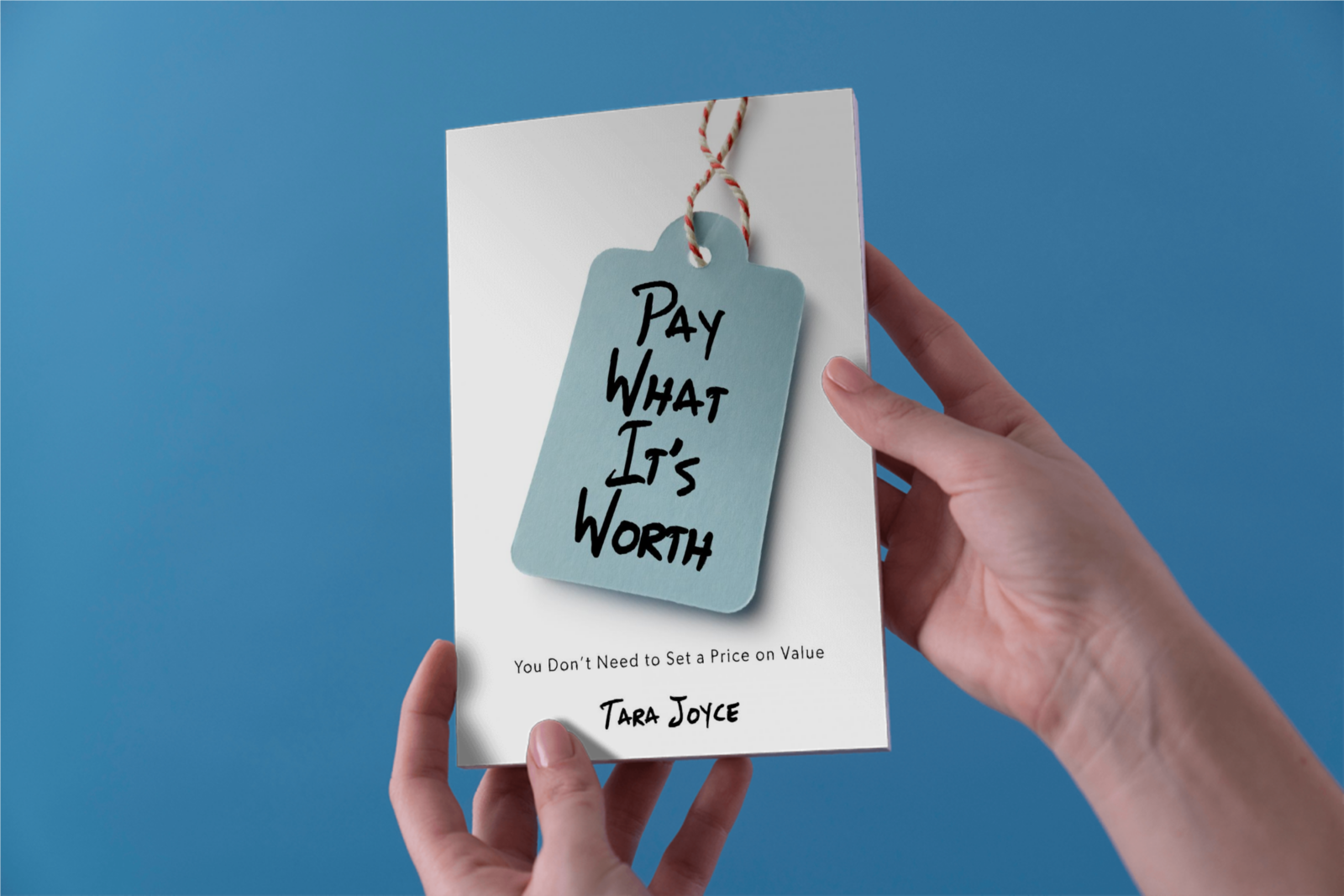
by Tara Joyce | May 15, 2013 | Pay What It's Worth Pricing

I’m curious about selling products online using PWIW and how it can work best. So, about six months ago I turned some communication tools I’d created over the years into products and began selling them in my store using PWIW.
Using PWIW for an Online Store
For my experiment, I wanted to figure out a strong way of selling a product online using PWIW. My first task (I felt) was to find software to help me with the buying and selling of my products. I needed a shopping cart tool to enable the sales transaction and to provide the product to buyers after sale. After doing research I decided upon using e-junkie. I have been happy with this decision.
The second decision I needed to make was how I was going to employ the e-junkie shopping cart with PWIW pricing. As with most online shopping carts, while it allows the customer to set the price of the item (often called a donation), it also requires the seller to set a suggested price.
Suggested Prices Signify Something
One of those things they can signify is what I think the thing I’m selling is worth. And for this experiment, that’s not what I wanted to do. I wanted you alone to decide what the product is worth to you.
But this was not, and is not, an option currently with online shopping carts — to set NO suggested price — so I needed to set the suggested price at something. The value I decided to use (for every product’s suggested price) was what I felt was a ridiculously low value ($0.07). My hope was this suggested price signified, please think about what you value this at because this price is clearly not a fair one.
It was my hypothesis that $0.07 was such an insignificant value to give/pay that it would be altered by each buyer. Most of us would not feel good giving $0.07 to a person in need, nor as a tip for service. And what can we puchase for that amount, outside of loose candy?
Despite this truth about the value of $0.07, my experiment yielded a handful of people that gave this amount to a faceless shopping cart in return for a communication tool created by me in support of them.
(It should be noted that no profit is made from online sales roughly less than $0.50 due to PayPal’s costs to process the transaction.)
A Curious Result
This is not to say there hasn’t been customers that have given fairly, despite the $0.07 suggested price. The fair are the majority in my PWIW experiment. But I found it curious, this minority that used the $0.07 suggested price as their price. They, I feel, are something to consider further.
I theorized there was something in my communication, namely the suggested price, that was contributing to this outcome. I wondered if by setting the suggested price very low, I was unconsciously sending a message about how I valued my work. What does it say about me and how I value my products when I set the suggested price low?
My Question
If these people exist, those that do not consciously consider how they value a product, and you want to sell something online using PWIW, how can you improve the exchange so that they behave more fairly?
My Theory
I’m theorizing that when the suggested price is set extremely low and there is no human connection, the communication it sends allows others to more easily react from a scarcity mindset and not value the product fairly, nor pay fairly.
Trying Something Different
Rather than setting the suggested price ridiculously low ($0.07) for each of the products in my store, I’ve set it ridiculously high ($777).
I am still hoping the suggested price will signify, please think about what you value this at because this price is clearly not a fair one. I am interested in how this higher suggested price affects the behaviour of those customers who are buying unconsciously.
In six months time, I’ll let you know what my experiment yields.
photo credit: kevin dooley

by Tara Joyce | May 3, 2011 | Featured, Pay What It's Worth Pricing
As a practitioner of Pay What It’s Worth pricing, I see the business approach of asking a client to pay-what-they-can as a very different thing. Each approach communicates very different things about your brand, and the exchange you seek. Care to explore this with me deeper?
Exploring Pay What You Can Pricing and What It Communicates
As a business owner, communicating that others are free to pay-what-they-can for your work positions you as willing to sell your work in charity. (You may want to consider at this point whether your business, or your clients, is, in fact, a charity.) In many cases neither party is a charity, so what you are truly communicating is that it’s okay for a client to pay whatever they *think* they can, and that you are open and lenient to allowing others to value your work at less than it’s worth, so long as the person deems they need it.
Now this is only my opinion, but I feel if you are responsible enough to identify a need and seek a solution for it, than you are also responsible enough to find the means for fulfilling that need — i.e., if you want it, you need to find a way to get it. I see no long-term value in not holding people (and businesses) responsible for fairly paying for a professionals energy and time. If you can determine that you want the service, and you go out and seek it, then you need to have a plan for how you are going to obtain it fairly.
By stating that your clients need only to pay-what-they-can, you are first, and foremost, communicating that you see them as lacking (you can’t afford what I think this is worth so I’ll let you pay me what you can), and encouraging them to act in this scarcity mindset. Secondly, you are encouraging them not to consider the long-term value of what they are receiving but instead to focus on what they *think* they can afford in the moment.
An initial question I would ask about this approach is: What leads you think that your potential clients have a scarcity of money and need to pay only what they can? Secondly: Of what benefit is it to encourage scarcity thinking around money? Do you see money as scarce? How do you think this scarcity message might affect the mindset of your buyers when they pay you? Unknowingly, you are positioning your work to be undervalued and attracting clients who are looking for a deal, rather than attracting clients who seek a fair value exchange.
With Pay What You Can (PWYC) pricing, the value exchange is focused on “what I can get”, where you are letting the customer receive what they need and pay what they feel they can afford, despite what the work may be worth. Communicating this message may be doing both your business and your potential clients a disservice, unless your undertaking an act of charity.
Exploring Pay What It’s Worth and What It Communicates
As a business owner, positioning your business offerings as Pay What It’s Worth (PWIW), you are communicating that you are willing to sell your work at it’s perceived value, as determined by the client. With this position, you are challenging your client to think deeply and honestly about the value you bring to their business and to pay you accordingly. You are not communicating to your potential client that they cannot afford your services. If anything, you are communicating that you trust the client, and the excellence of your work, enough to let them determine its value. Pay What It’s Worth pricing makes no judgments about the financial abilities of the parties involved. With this strategy, you are essentially challenging potential clients to look at the value exchange occurring, and to focus not on what they can get, but what they can give in gratitude for what they have received. You are also asking them to consider the standard prices for things, and question whether those market prices accurately reflect the true value of what they are receiving from you.
You are not judging what others can and can not afford, you are simply stating that if you agree to work with someone and they employ your services, you trust that they will pay you fairly for what you provide to them. You are supporting both your Self and your clients in truly and honestly identifying and determining a value for what each party contributes to the exchange, monetary and otherwise.
PWIW is Not PWYC
There are distinct differences in what each pricing system communicates — about your business and work and about the people who can best benefit from it. What message do you want to send?



